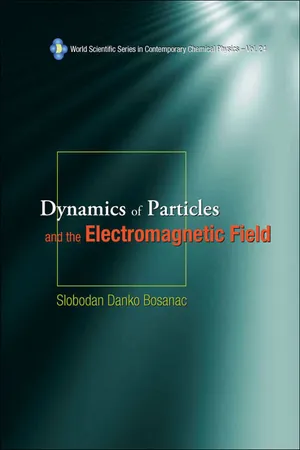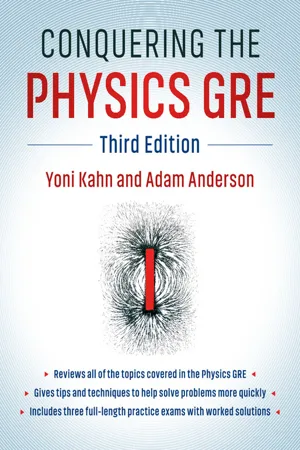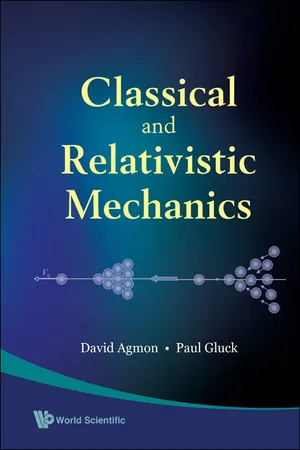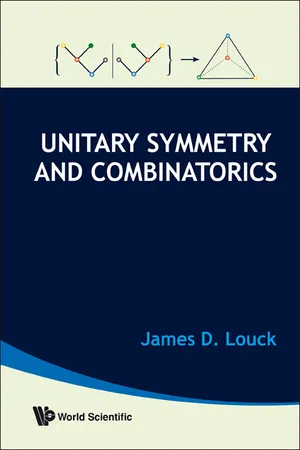Physics
Angular Momentum
Angular momentum is a measure of the rotational motion of an object. It is a vector quantity defined as the cross product of the position vector and the linear momentum of an object. In simpler terms, it describes how an object is spinning or rotating and is conserved in the absence of external torques.
Written by Perlego with AI-assistance
Related key terms
1 of 5
12 Key excerpts on "Angular Momentum"
- eBook - PDF
- Robert Resnick, David Halliday, Kenneth S. Krane(Authors)
- 2016(Publication Date)
- Wiley(Publisher)
This is the second of the major conservation laws we have discussed. Along with conservation of linear momentum, conservation of Angular Momentum is a general result that is valid for a wide range of systems. It holds true in both the relativistic limit and in the quantum limit. No excep- tions have ever been found. Like conservation of linear momentum in a system on which the net external force is zero, conservation of Angular Momentum applies to the total Angular Momentum of a sys- tem of particles on which the net external torque is zero. The Angular Momentum of individual particles in a system may change due to internal torques ( just as the linear mo- mentum of each particle in a collision may change due to internal forces), but the total remains constant. Angular Momentum is (like linear momentum) a vector quantity so that Eqs. 10-15 is equivalent to three one- dimensional equations, one for each coordinate direction through the reference point. Conservation of angular mo- mentum therefore supplies us with three conditions on the motion of a system to which it applies. Any component of the Angular Momentum will be constant if the correspond- ing component of the torque is zero; it might be the case that only one of the three components of torque is zero, which means that only one component of the angular mo- mentum will be constant, the other components changing as determined by the corresponding torque components. For a system consisting of a rigid body rotating with an- gular speed about an axis (the z axis, say) that is fixed in an inertial reference frame, we have (10-16) where L z is the component of the Angular Momentum along the rotation axis and I is the rotational inertia for this same axis. If no net external torque acts, then L z must remain constant. - eBook - PDF
- Paul Peter Urone, Roger Hinrichs(Authors)
- 2012(Publication Date)
- Openstax(Publisher)
By now the pattern is clear—every rotational phenomenon has a direct translational analog. It seems quite reasonable, then, to define Angular Momentum L as (10.90) L = Iω. This equation is an analog to the definition of linear momentum as p = mv . Units for linear momentum are kg ⋅ m/s while units for Angular Momentum are kg ⋅ m 2 /s . As we would expect, an object that has a large moment of inertia I , such as Earth, has a very large Angular Momentum. An object that has a large angular velocity ω , such as a centrifuge, also has a rather large Angular Momentum. Making Connections Angular Momentum is completely analogous to linear momentum, first presented in Uniform Circular Motion and Gravitation. It has the same implications in terms of carrying rotation forward, and it is conserved when the net external torque is zero. Angular Momentum, like linear momentum, is also a property of the atoms and subatomic particles. Example 10.11 Calculating Angular Momentum of the Earth Strategy No information is given in the statement of the problem; so we must look up pertinent data before we can calculate L = Iω . First, according to Figure 10.12, the formula for the moment of inertia of a sphere is (10.91) I = 2MR 2 5 so that (10.92) L = Iω = 2MR 2 ω 5 . 366 Chapter 10 | Rotational Motion and Angular Momentum This OpenStax book is available for free at http://cnx.org/content/col11406/1.9 Earth’s mass M is 5.979×10 24 kg and its radius R is 6.376×10 6 m . The Earth’s angular velocity ω is, of course, exactly one revolution per day, but we must covert ω to radians per second to do the calculation in SI units. Solution Substituting known information into the expression for L and converting ω to radians per second gives (10.93) L = 0.4 ⎛ ⎝ 5.979×10 24 kg ⎞ ⎠ ⎛ ⎝ 6.376×10 6 m ⎞ ⎠ 2 ⎛ ⎝ 1 rev d ⎞ ⎠ = 9.72×10 37 kg ⋅ m 2 ⋅ rev/d. - eBook - PDF
- Henrik Smith(Author)
- 1991(Publication Date)
- WSPC(Publisher)
152 Introduction to Quantum Mechanics 7 Angular Momentum According to classical mechanics the Angular Momentum of a particle with respect to a given point in space is conserved, when the potential energy of the particle only depends on the distance from the particle to the given point. Such a potential is called a central field. Since the force on the particle moving in a central field is directed towards or away from the given point, it follows that the moment of the force with respect to this point must be zero, and the Angular Momentum with respect to the same point is therefore independent of time. The conservation of Angular Momentum is a consequence of the symmetry of the system, the potential energy being invariant under rotations about the given point. As we shall see, the existence of this symmetry means that the operators for each component of the Angular Momentum commute with the Hamiltonian. However, the individual components of the Angular Momentum operator do not commute with each other. This may be seen from the classical expression for the Angular Momentum L, L = r x p , (7.1) where r and p in quantum mechanics are represented by operators which do not commute. The commutation relations for the components of the Angular Momentum will be derived in Section 7.1.2 below, starting from the classical expression (7.1). These commutation relations imply that the three components cannot take on definite values at the same time. It is however possible to find states which are simultaneous eigenstates for one of the components of the Angular Momentum and the square of its length. The eigenvalues for one of the com-ponents of the Angular Momentum turn out to be an integer or a half-integer times the Planck constant ft. The half-integer values cannot be derived from the orbital Angular Momentum alone. They are a consequence of the Lorentz invariance that must apply to the wave equation describing the motion of the particle. - eBook - PDF
- William Moebs, Samuel J. Ling, Jeff Sanny(Authors)
- 2016(Publication Date)
- Openstax(Publisher)
however, we investigate the Angular Momentum of a single particle. This allows us to develop Angular Momentum for a system of particles and for a rigid body. Angular Momentum of a Single Particle Figure 11.9 shows a particle at a position r → with linear momentum p → = m v → with respect to the origin. Even if the particle is not rotating about the origin, we can still define an Angular Momentum in terms of the position vector and the linear momentum. Angular Momentum of a Particle The Angular Momentum l → of a particle is defined as the cross-product of r → and p → , and is perpendicular to the plane containing r → and p → : (11.5) l → = r → × p → . Figure 11.9 In three-dimensional space, the position vector r → locates a particle in the xy-plane with linear momentum p → . The Angular Momentum with respect to the origin is l → = r → × p → , which is in the z-direction. The direction of l → is given by the right-hand rule, as shown. The intent of choosing the direction of the Angular Momentum to be perpendicular to the plane containing r → and p → is similar to choosing the direction of torque to be perpendicular to the plane of r → and F → , as discussed in Fixed-Axis Rotation. The magnitude of the Angular Momentum is found from the definition of the cross-product, l = rp sin θ, where θ is the angle between r → and p → . The units of Angular Momentum are kg · m 2 /s . As with the definition of torque, we can define a lever arm r ⊥ that is the perpendicular distance from the momentum vector p → to the origin, r ⊥ = r sin θ. With this definition, the magnitude of the Angular Momentum becomes l = r ⊥ p = r ⊥ mv. Chapter 11 | Angular Momentum 555 We see that if the direction of p → is such that it passes through the origin, then θ = 0, and the Angular Momentum is zero because the lever arm is zero. In this respect, the magnitude of the Angular Momentum depends on the choice of origin. - Joseph C. Amato, Enrique J. Galvez(Authors)
- 2015(Publication Date)
- CRC Press(Publisher)
But spin is only one example of Angular Momentum. We will now broaden the definition of I L , and show that all bodies, non-rotating ones, even bodies moving along a straight line, may possess Angular Momentum. Moreover, we will see that the total Angular Momentum of an isolated system does not change, giving us a new conservation law to add to those of momentum and energy. Conservation of Angular Momentum is the crux of Kepler’s second law (the equal area law), and we will use it to find the shape of planetary orbits and to predict the trajectories of asteroids, comets, and spacecraft. Like momentum and energy, angu -lar momentum is a powerful tool for studying motion, and it will be employed in Chapters 13 and 14 to study the behavior of rigid bodies in simple lab-scale situations as well as in phenomena that challenge our understanding of the cosmos. 12.2 BROADER DEFINITION OF Angular Momentum Imagine that you are at point A , observing the motion of a small body. Relative to A , the body is located at position I r and moving with momentum I p (see Figure 12.1a ). The Angular Momentum I L of the body relative to A is formally defined by the cross product I I I L r p ≡ × . (12.1) According to the properties of the cross product, I L is perpendicular to the plane containing I r and I p , and points in the direction determined by the right hand rule. (For a review of cross products, see Section 8.3.) The magnitude of I L is given by L = rp sin θ , where θ is the angle between I r and I p ( θ < 180 ° ). Alternatively, we may express the magnitude as L = rp ⊥ , where p ⊥ = p sin θ is the component of I p perpendicular to I r , or equivalently as L = r ⊥ p (see Figure 12.1b ). EXERCISE 12.1 Show that the Angular Momentum relative to point A of a body moving with no forces acting on it is a constant, that is, I I I I L r L r ( ( ) ). = ′ A r v r ΄- eBook - PDF
Dynamics of Particles and the Electromagnetic Field
(With CD-ROM)
- Slobodan Danko Bosanac(Author)
- 2005(Publication Date)
- WSPC(Publisher)
Chapter 4 Angular Momenturn 4.1 General Remarks Angular Momentum, which is defined in (1.18), is a very important quantity in dynamics of a particle, despite the fact that it is invariant of motion only if the forces are centrally symmetric. By using the probability current (1.13) Angular Momentum is defined as d3r d3p r ' x $p(r',$, t ) = m d3r r' x j(7, t) J' which is often more convenient for discussing its properties. In particu- lar three typical contributions to the Angular Momentum are distinguished, and two of them are deduced from the probability current. It should be emphasized though that these contributions are often not easily disentan- gled in real situations. When one talks about various contributions it is meant that there are circumstances when only one is dominant. One typical contribution is when the probability current parametrizes (or approximately parametrizes) as J(r',t) = (i7) P(F,t), where (i?) is the average velocity of the particle and P(r',t) is the probability density for the coordinates, which is defined in (1.13). For this parametrization the average of the probability current is not zero -. (4 = / d 3 r .f(r',t) # 0 and in this case the Angular Momentum is estimated as 51 52 Dynamics of Particles and the Electromagnetic Field where (F) is the average position of the particle (3 = / d 3 r FP(?,t). This Angular Momentum is associated with the motion of the probability density P(F, t ) as the whole and will be called the orbital angular momen- tum. Very often one encounters situation when the average probability cur- rent is zero for example when the particle is free and not moving, meaning that its average velocity is zero (see Section 2.2). Angular Momentum of the particle is in this case zero. However, the condition (4.1) is not sufficient for the Angular Momentum to be zero, and one example that shows this is treated in Section 1.2.1. - eBook - PDF
- Yoni Kahn, Adam Anderson(Authors)
- 2018(Publication Date)
- Cambridge University Press(Publisher)
We know M, m, V , v, and θ here and we are solving for φ. Thus all we actually need is the second of the two equations, which gives us the result that φ = arcsin − M m sin θ . The minus sign makes good physical sense: if θ is positive, the mass-M ball goes up, giving a negative φ. The ball of mass m goes down, conserving momentum perpendicular to the initial direction. For practice, do a limiting-case analysis for the M and m dependence as well. final state, then set the two equal. The Angular Momentum of a point particle of linear momentum p is defined by L = r × p, (1.16) where r is the vector from a chosen reference point to the par- ticle. Remember that rotational motion is always defined with respect to a reference point or axis. For an extended body we also have L = I ω, (1.17) where I is the moment of inertia and ω is the angular veloc- ity vector. Conceptually, I plays the same role as the mass m in the definition of linear Angular Momentum p = mv. Extending the metaphor, the analogue of force F for rotational motion is the torque τ = r × F. (1.18) Classic problems include merry-go-rounds and spinning disks. For instance, if a person jumps onto a spinning disk with a known moment of inertia, how does the rotational velocity change? Just equate L = I ω in the initial and final states. We wrote Angular Momentum and torque in their vector form for completeness above. Note, however, that the vector form is only really needed for the definitions of L and τ . The analogues of the equations p = mv and F = dp/dt are only used on the GRE in their scalar forms: L = I ω, (1.19) τ = dL dt . (1.20) Problems involving Angular Momentum can also be con- ceptual, asking for the configuration of momentum, velocity, and acceleration vectors for a system involving rotational motion. The key point to remember is that the angular - eBook - PDF
- David Agmon, Paul Gluck;;;(Authors)
- 2009(Publication Date)
- WSPC(Publisher)
Example 2 Angular Momentum for motion in a circle. A particle of moss m moves in a circle of radius r with constant velaeity V (> (a) Calculate its Angular Momentum L relative to the center O. (h) What is the moment of the force acting on the particle 9 (c) Express L in terms of the angular velocity co. (d ) Express the kinetic energy in terms ofL. Solution la) From its definition, the direction of L is perpendicular to the plane of the circle, out of the page. Since r is perpendicular to V 0 , L = rp sin 90 = mV {) r, (b) Since L is constant in both magnitude and direction, the resultant moment vanishes. We can also see this from the fact that the centripetal force is parallel to is and so r = rxF = 0. (c) L = rn(V)r = m((D- r)r = mrO) = Id) (since / = mr 1 ) I . 1 (m^ J r 1 1 {mV v f 1 Is ! Is id 1 E. = — mV. i = —I m 2mj { r 1 j 2 mr 2 mr 2 I Example 3 Motion under the influence of a central g^ force. Lei a particle move in a central force field of the o form Fir) = fifi r. Prove the following, (a) Its Angular Momentum with respect to the center offorce is a constant, (h) its motion is confined to a plane, 388 Classical and Relativistic Mechanics / P O / Plane of motion Solution (a) Since the force is parallel to f , its moment about the center of force O vanishes. Therefore the Angular Momentum relative to O is a constant. (b) By definition, the direction of L is perpendicular to the plane formed by the radius vector and the velocity. But since L is a constant, the velocity and the radius vector must remain in the same plane. Example 4 Kepler's law of areas. Prove thai for a body moving influence of any central force, the radius vector joining it to the centt sweeps out equal areas in equal times. This is a generalization of Kepler's area rule for planets around the Sun, stated in section 10.1. Solution Consider the particle at the time t = 0 and At later. The area M swept out is the shaded area in the diagram. - eBook - PDF
Angular Momentum
An Illustrated Guide to Rotational Symmetries for Physical Systems
- William J. Thompson(Author)
- 2008(Publication Date)
- Wiley-VCH(Publisher)
Physics uses several kinds of language: natural language (such as English), graphical language (schematics such as Figure 5.1, diagrams, and graphs), and mathematics. When mathematics is used in physics it must be both appropriate and correct. Section 5.3.1 emphasizes that paradoxical results can be obtained if physi- cal concepts are not expressed appropriately and manipulated by the mathematics. As summarized in Figure 5.1, physics involves a loop of four themes: concepts, language, mathematics, and observations. We begin the chapter by discussing in Section 5.1 rotational symmetry and dy- namical Angular Momentum, especially the role of Planck‘s constant. In Section 5.2 we progress to the uncertainty relations for Angular Momentum as interpreted in quantum mechanics. We show that the semiclassical vector model (Section 5.3) is useful for visualizing Angular Momentum. The model also helps when considering how to combine two angular momenta (Section 7.1). Waves, particularly Schro- dinger wave mechanics, and their relation to Angular Momentum are discussed extensively in Section 5.4, where we also derive and present visualizations of par- tial-wave expansions involving Bessel functions. Section 5.5 summarizes the con- ceptual development of Angular Momentum from a historical perspective. The in- evitable problems round out the chapter. 5 . 1 ROTATIONAL SYMMETRY AND DYNAMICAL Angular Momentum Our aim in this section is to develop the connection between rotational symmetry (geometry) and dynamical Angular Momentum (physics). We begin by showing in Section 5.1.1 the correspondence between geometrical, quantal, and classical Angular Momentum. Then we consider in Section 5.1.2 the particular case of orbital Angular Momentum and the quantum-classical correspondence through an Ehrenfest theorem for orbital Angular Momentum, analogous to that often derived for the quantum analogue of Newton’s force equation. - Raymond Serway, John Jewett(Authors)
- 2018(Publication Date)
- Cengage Learning EMEA(Publisher)
A particle moving in a straight line such as the skater in Figure 11.3 has Angular Momentum about any axis displaced from the path of the particle, such as an axis through the pole in Figure 11.3. See the What If? in Example 11.3. Example 11.3 Angular Momentum of a Particle in Uniform Circular Motion A particle moves at constant speed in the xy plane in a circular path of radius r as shown in Figure 11.5. Find the magnitude and direction of its Angular Momentum relative to an axis through O when its velocity is v S . S O L U T I O N Conceptualize The linear momentum of the parti- cle is always changing in direction (but not in mag- nitude). You might therefore be tempted to conclude that the Angular Momentum of the particle is always changing. In this situation, however, that is not the case. Let’s see why. Categorize We use the definition of the Angular Momentum of a particle discussed in this section, so we categorize this exam- ple as a substitution problem. Use Equation 11.14 to evaluate the magnitude of L S : L 5 mvr sin 908 5 mvr This value of L is constant because all three factors on the right are constant. The direction of L S also is constant, even though the direction of p S 5 m v S keeps changing. To verify this statement, apply the right-hand rule to find the direction of L S 5 r S 3 p S 5 m r S 3 v S in Figure 11.5. Your thumb points out of the page, so that is the direction of L S . Hence, we can write the vector expression L S 5 smvrd k ⁄ . If the particle were to move clockwise, L S would point downward and into the page and L S 5 2smvrd k ⁄ . A particle in uniform circular motion has a constant Angular Momentum about an axis through the center of its path. W H A T I F ? The particle in Figure 11.4 moves in a straight line at constant speed along a path parallel to the linear momentum vector p S . Is the Angular Momentum of the particle constant in this case? Answer Yes. In Equation 11.14, m and v are constant while r and f vary in time.- eBook - PDF
- James D Louck(Author)
- 2008(Publication Date)
- World Scientific(Publisher)
There are, fortunately, general invariance properties of the Schr¨ odinger equation and its solution state functions for a complex composite phys-ical systems that can be used to classify the quantum states of physical systems into substates available to the system. Our focus here is on the properties of the total Angular Momentum of a physical system, which is a quantity L that has a vector expression L = L 1 e 1 + L 2 e 2 + L 3 e 3 in the right-handed frame ( e 1 , e 2 , e 3 ) and the expression L = L 1 e 1 + L 2 e 2 + L 3 e 3 in a second rotated right-handed frame ( e 1 , e 2 , e 3 ) . At a given instant of time, necessarily L = L , since these quantities are just redescriptions of the total Angular Momentum of the system at a given time. The total Angular Momentum is a conserved quantity; that is, d L /dt = 0 , for all time t, and this property makes the total Angular Momentum an important quantity for the study of the behavior of complex physical systems. For a system of n point particles, the total Angular Momentum relative to the origin of the reference frame ( e 1 , e 2 , e 3 ) is obtained by vector addition of that of the individual parti-cles by L = ∑ n i =1 L i , where L i is expressed by the vector cross product L i = x i × p i in terms of the vector position x i = x 1 i e 1 + x 2 i e 2 + x 3 i e 3 and the vector linear momentum p i = p 1 i e 1 + p 2 i e 2 + p 3 i e 3 of the particle labeled i. While Angular Momentum can be exchanged between interact-ing particles, the total Angular Momentum remains constant in time for an isolated physical system of n particles. The quantum-mechanical op-erator interpretation of such classical physical quantities is obtained by Schr¨ odinger’s rule p i → − i ∇ i , = h/ 2 π, where h is Planck’s constant. The reference frame vectors ( e 1 , e 2 , e 3 ) remain intact. 1.1. BACKGROUND AND VIEWPOINT 13 The viewpoints of Newtonian physics and quantum physics may be contrasted in many ways. - No longer available |Learn more
Physics for Scientists and Engineers
Foundations and Connections, Extended Version with Modern Physics
- Debora Katz(Author)
- 2016(Publication Date)
- Cengage Learning EMEA(Publisher)
All Rights Reserved. May not be copied, scanned, or duplicated, in whole or in part. WCN 02-300 13-7 Conservation of Angular Momentum 379 All content on this page is © Cengage Learning. CHECK and THINK Because the CD slows down and because its angular velocity is in the negative z direction, the change in its Angular Momentum is in the positive z direction. In Problem 12.82, you should find that the angular acceleration is also in the positive z direction. Again, it is not a coincidence. 13-7 Conservation of Angular Momentum We found in Chapter 10 that when no net force acts on a system, the system’s trans- lational momentum is conserved, and this principle gave us a way to analyze com- plicated situations such as the decay of a nucleus. In this section, we will learn when and how to apply the principle of conservation of Angular Momentum. How- ever, to better understand conservation of Angular Momentum, we consider a system whose Angular Momentum is changing and derive another expression for Newton’s second law. DERIVATION Another Expression of Newton’s Second Law Another way to express Newton’s second law for a system is dL u tot dt 5 a t u ext (13.27) where t u ext is the total external torque exerted and L u tot is the system’s total Angular Momentum. Equation 13.27 holds for a single particle, a collection of particles, or an object. Our derivation is made simpler if we consider a single particle moving along a straight path (Fig. 13.28). A net force F u tot acts on the particle so that it speeds up along that path. We will show that for this particle, dL u dt 5 t u tot (13.28) Because the particle’s speed increases, its translational momentum also increases. The particle’s path is along the straight line shown, so r ' does not change, but because the translational momentum p increases, the particle’s Angular Momentum L around the z axis increases also.
Index pages curate the most relevant extracts from our library of academic textbooks. They’ve been created using an in-house natural language model (NLM), each adding context and meaning to key research topics.











